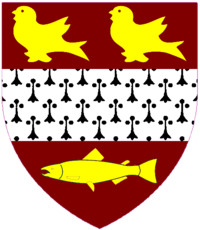John Sankey, 1st Viscount Sankey
PC | |
|---|---|
 | |
| Lord High Chancellor of Great Britain | |
| In office 7 June 1929 – 7 June 1935 | |
| Prime Minister | Ramsay MacDonald |
| Preceded by | The Viscount Hailsham |
| Succeeded by | The Viscount Hailsham |
| Personal details | |
| Born | 26 October 1866 |
| Died | 6 February 1948 (aged 81) |
| Nationality | |
| Political party | Labour |
| Alma mater | Jesus College, Oxford |
John Sankey, 1st Viscount Sankey,
Background and education
He was the son of Thomas Sankey, a grocer of
Political and legal career
Sankey began his practice as a barrister in south Wales, later specialising in workmen's compensation cases. In 1909 he was appointed a King's Counsel.[1][3]
Sankey became a judge of the
On Labour's victory in the 1929 general election, Sankey was appointed Lord Chancellor by Ramsay MacDonald,[1] and was raised to the peerage as Baron Sankey, of Moreton in the County of Gloucester.[7] He was one of the few Labour politicians to follow MacDonald into the National Government in 1931, and served as Lord Chancellor until 1935, when Stanley Baldwin re-entered office. In 1932 he was created Viscount Sankey, of Moreton in the County of Gloucester.[8]
Several of his judgments in the House of Lords have become landmark statements of law. Sankey's judgment in Woolmington v DPP [1935] AC 462 is famous for iterating the duty inherent on the prosecution to prove the prisoner's guilt beyond a reasonable doubt. In pertinent part, his judgment stated:
Throughout the web of the English criminal law one golden thread is always to be seen – that it is the duty of the prosecution to prove the prisoner's guilt subject to what I have already said as to the defence of insanity and subject also to any statutory exception...
This judgment is usually referred to as the "golden thread".[citation needed]
Sitting in the
Sankey Declaration
Sankey's name was associated with the Sankey Declaration of the Rights of Man,
- right to life
- protection of minors
- duty to the community
- right to knowledge
- freedom of thought and worship
- right to work
- right to personal property
- freedom of movement
- personal liberty
- freedom from violence
- right of law-making.
The Sankey Declaration was widely publicised by its sponsors at the time, but has since been largely forgotten, having been overtaken by the Universal Declaration of Human Rights.
Sankey played a key role in establishing the legal framework of the newly disestablished Church in Wales.
Personal life
Sankey never married. He died in London on 6 February 1948, aged 81, when the peerage became extinct.[1] He is buried in The Lower Cemetery of Moreton in Marsh, Gloucestershire.[citation needed] A house at his former school Lancing College is named after him.[10] Sankey endowed a scholarship for students at Jesus College Oxford seeking to practise at the English Bar.
Arms
  |
|
See also
- Coal Industry Commission Act 1919
- Lord Sankey's lower court judgments
- Lord Sankey's JCPC judgments
- List of Judicial Committee of the Privy Council cases
- List of Judicial Committee of the Privy Council cases originating in Canada
References
- ^ required.)
- ^ "Viscount John Sankey, Lord Chancellor – Roath's top brief". Roath Local History Society. 23 September 2020. Retrieved 2 March 2022.
- ^ "No. 28255". The London Gazette. 28 May 1909. p. 4060.
- ^ "The Cabinet Paters – Labour legislation". The National Archives. Retrieved 27 October 2022.
- ISBN 978-0-333-56081-5, retrieved 16 June 2022
- ^ "No. 33356". The London Gazette. 14 February 1928. p. 1044.
- ^ "No. 33508". The London Gazette. 21 June 1929. p. 4118.
- ^ "No. 33795". The London Gazette. 2 February 1932. p. 703.
- ^ "A Declaration of the Rights of Man; A charter prepared in 1940, under the Chairmanship of Lord Sankey, and originally drafted for discussion by H. G. Wells". Retrieved 5 January 2012.
- ^ "Sankey's | Lancing College | Independent Senior School & Sixth Form | Woodard | West Sussex | South of London". www.lancingcollege.co.uk. Retrieved 2 March 2022.
- ^ Debrett's Peerage. 1936.

